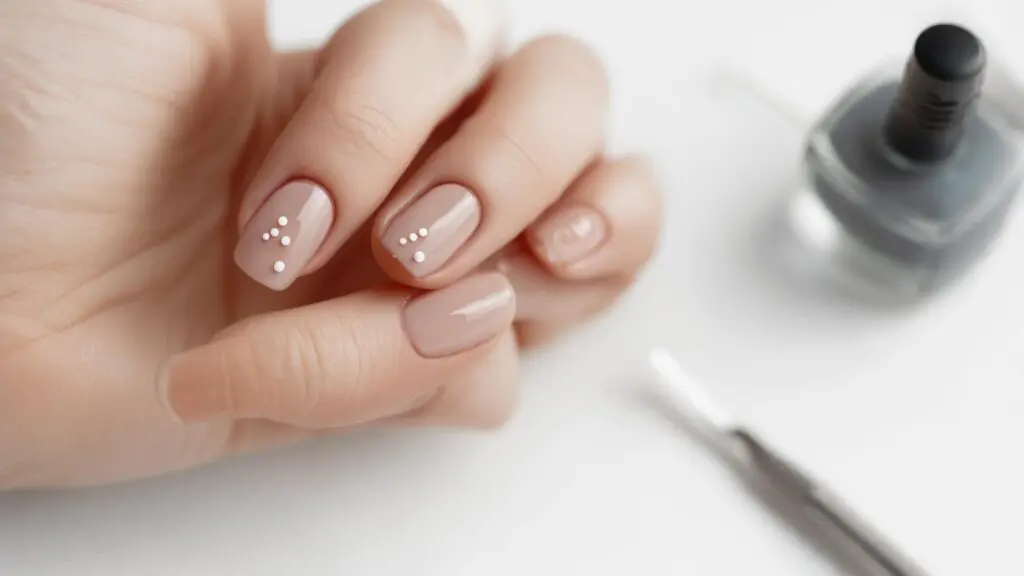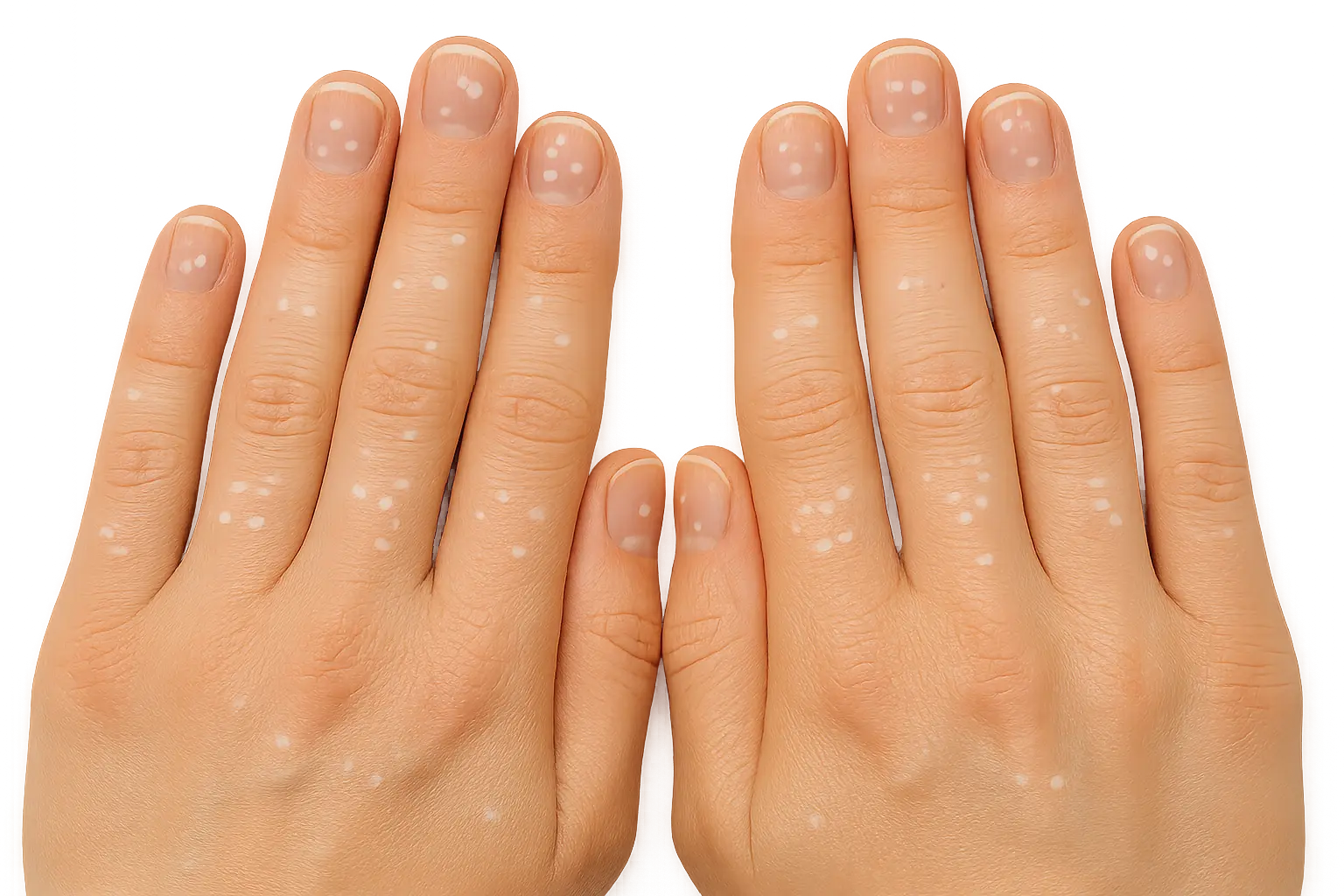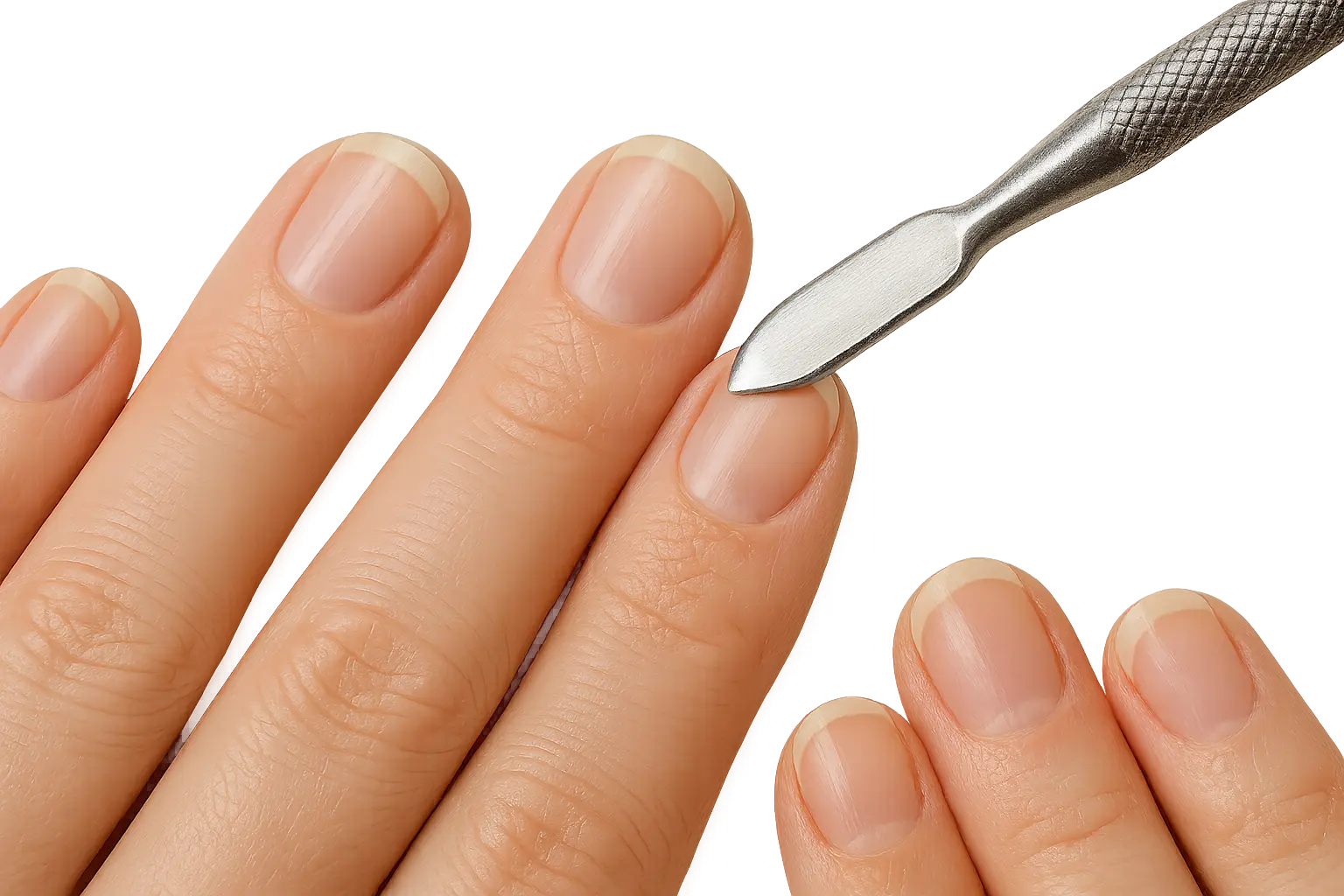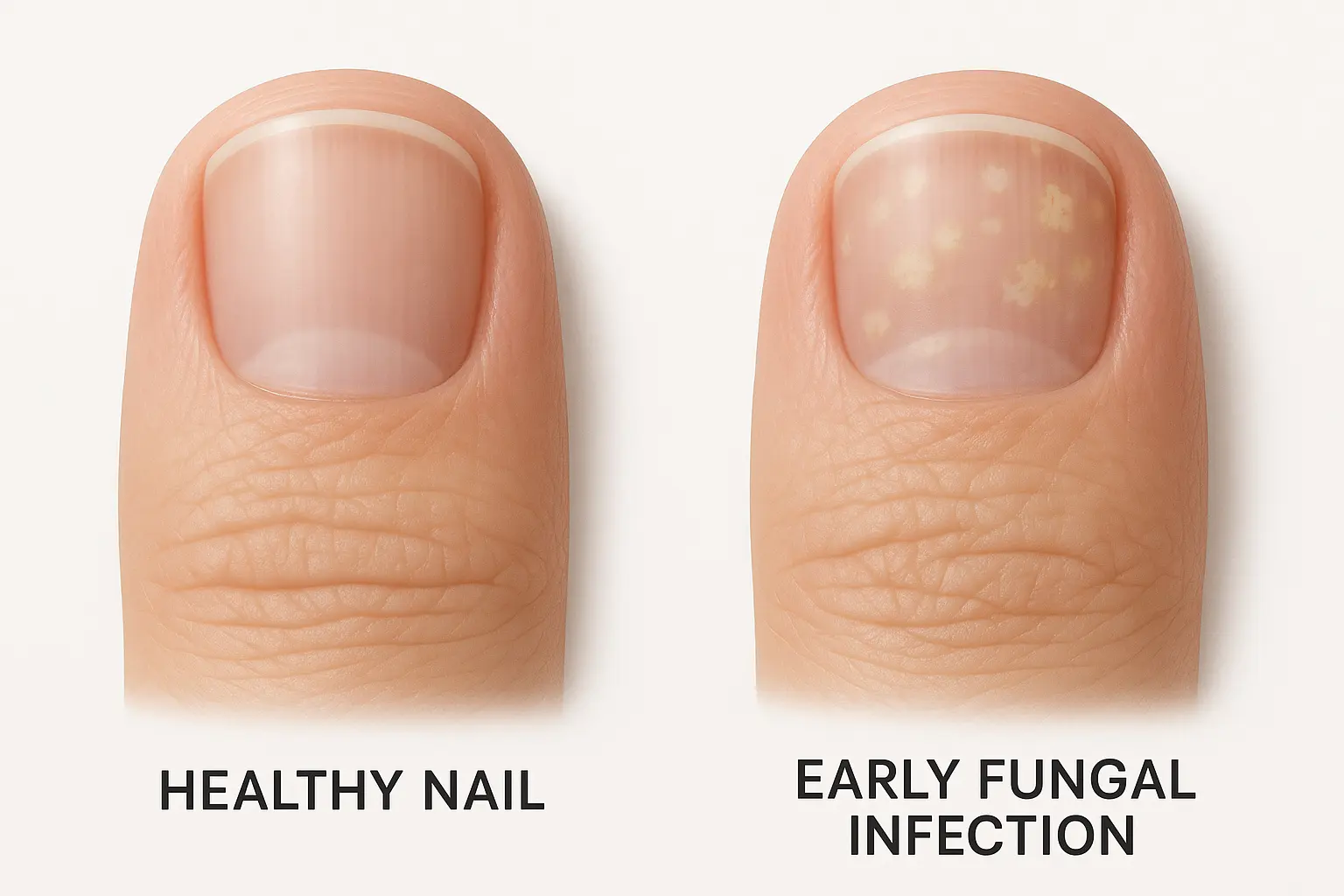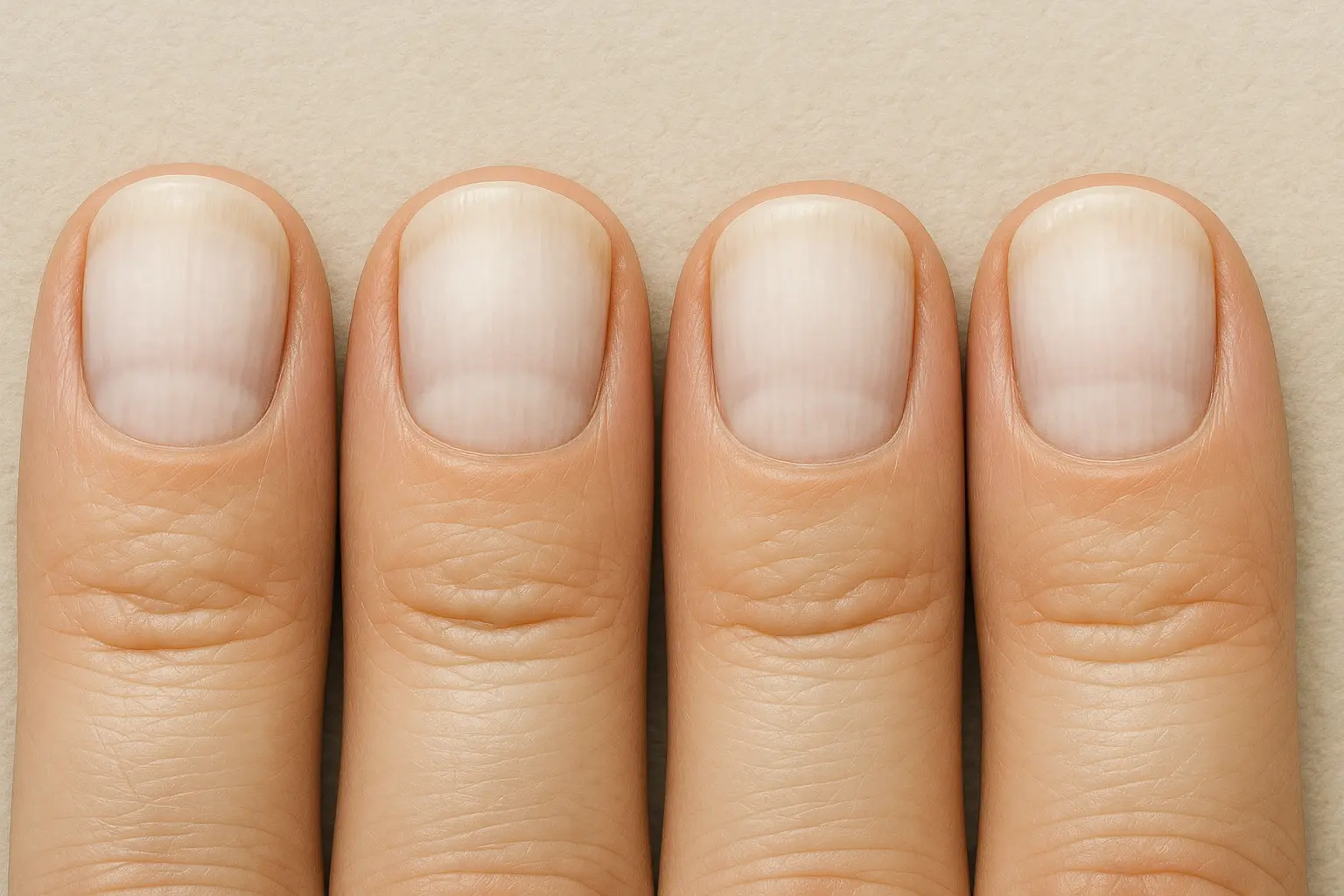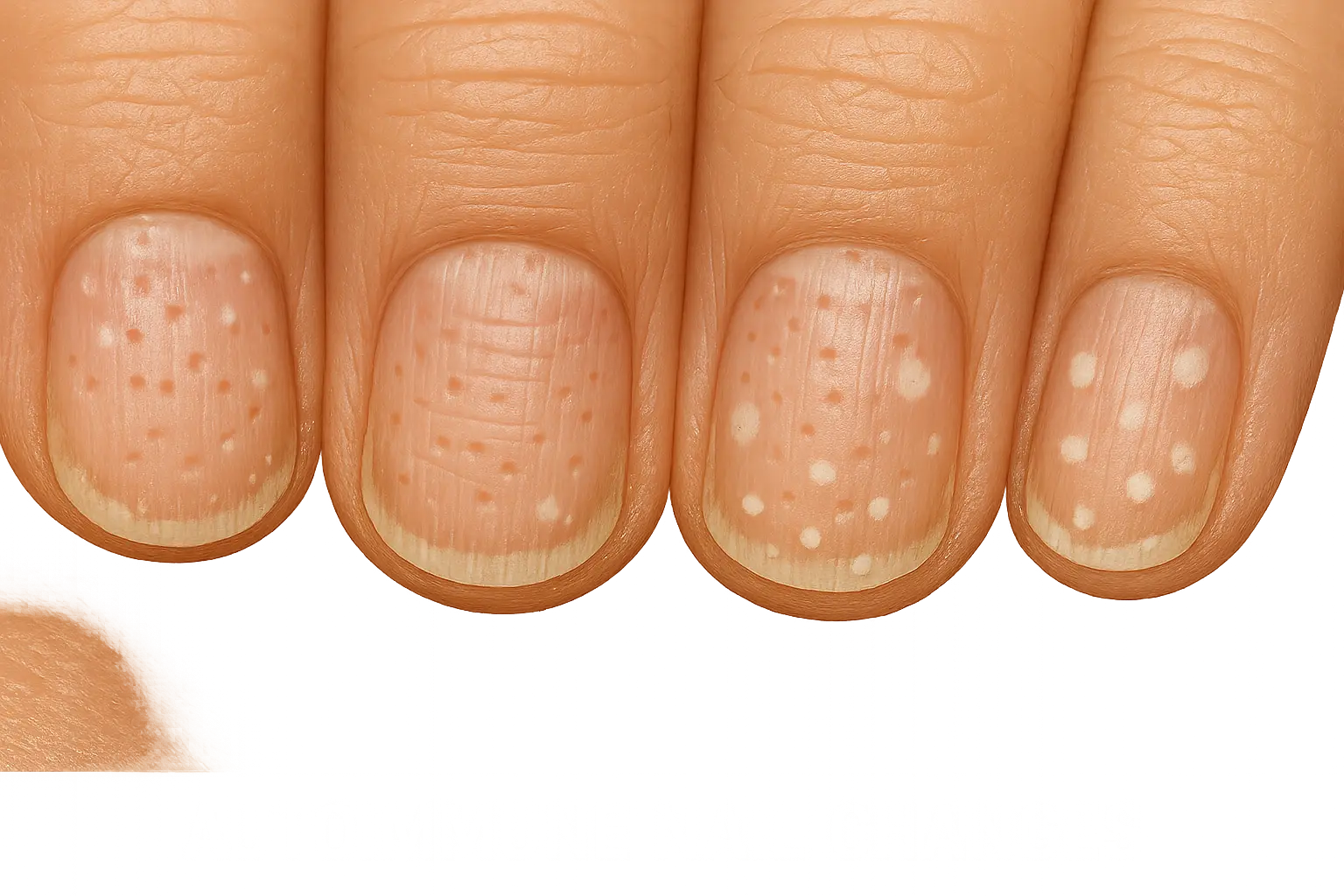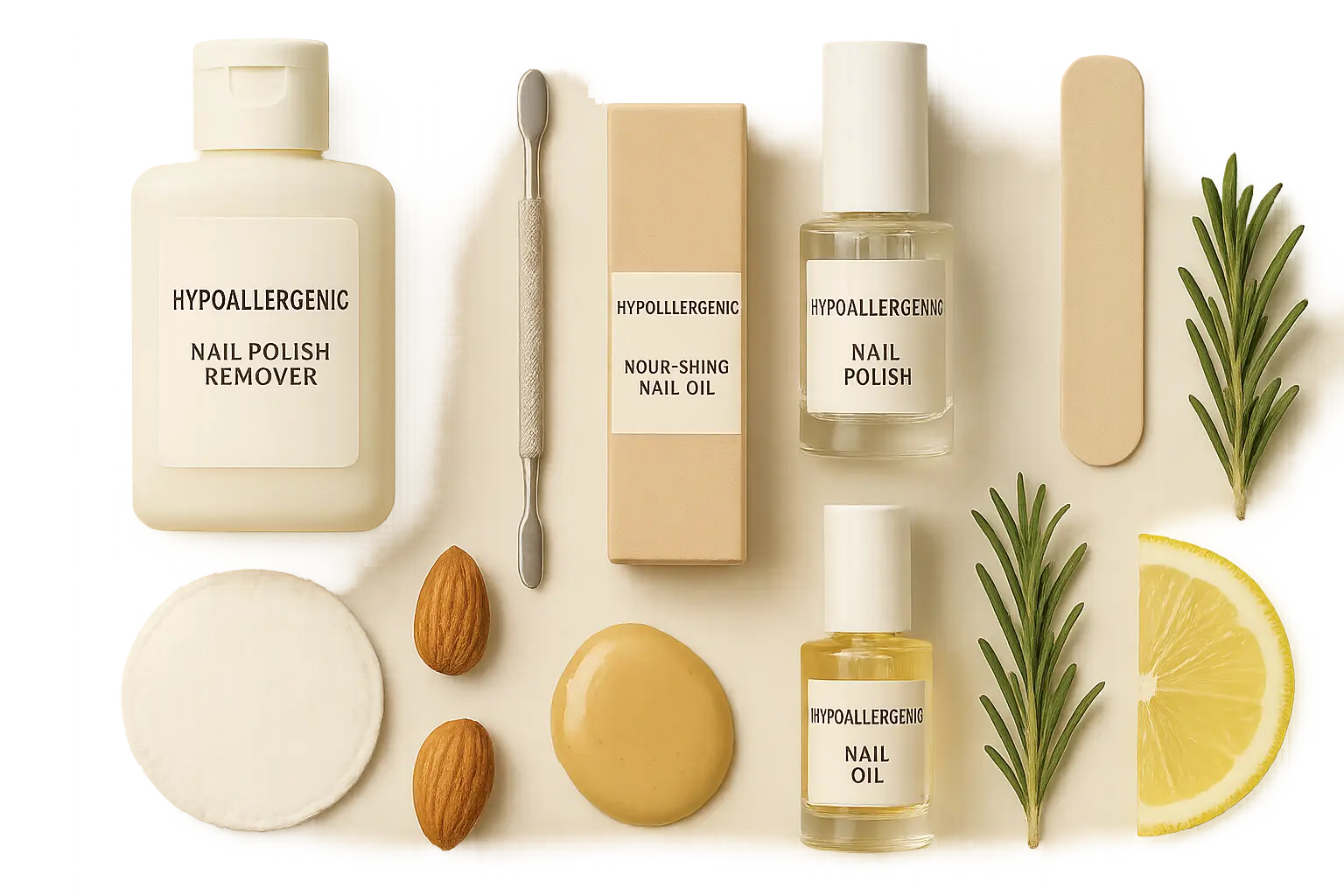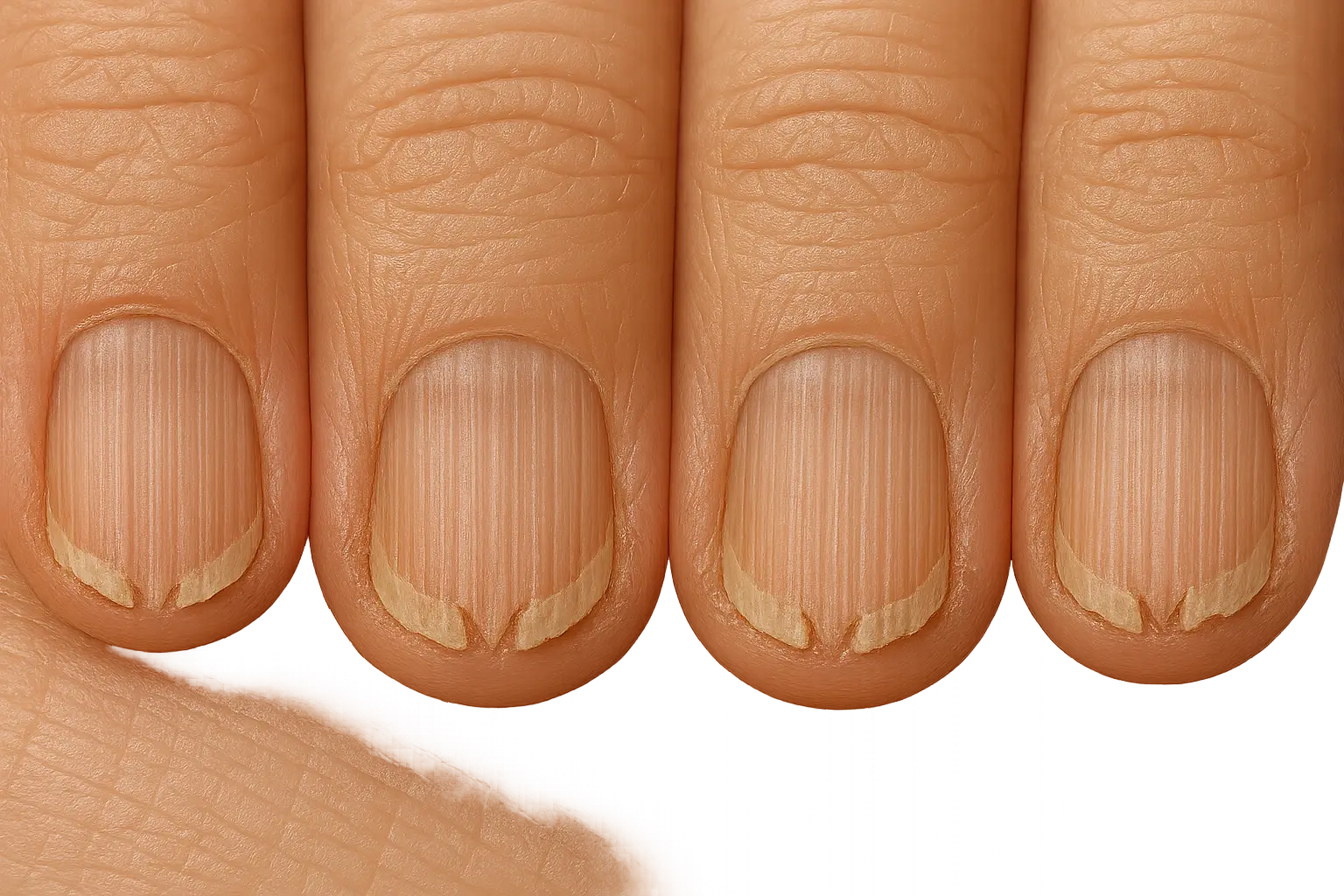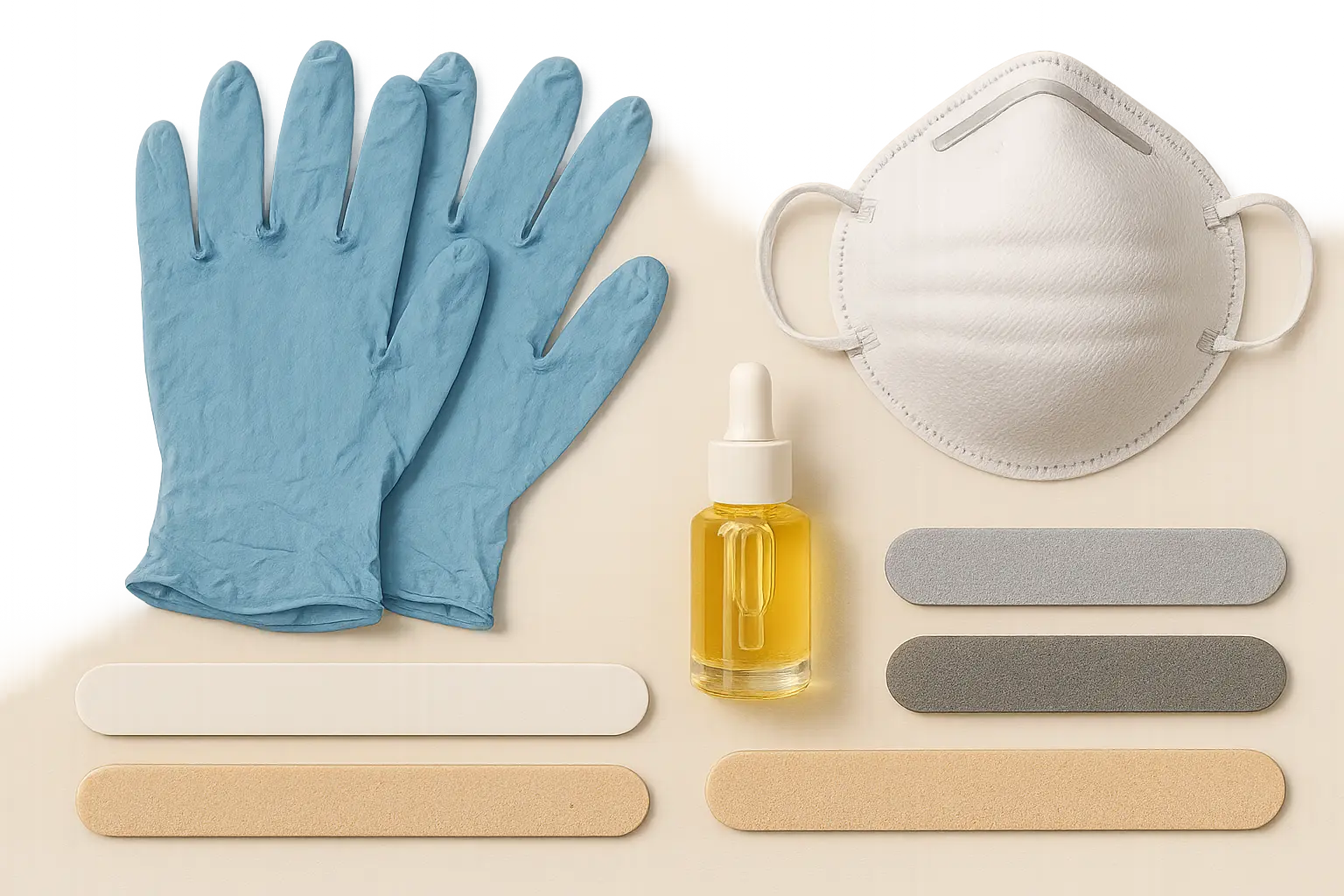I was frantically googling “white spots on nails” at 2 AM before my sister’s wedding when I noticed three tiny dots that seemed to appear overnight. Sound familiar? Turns out, they were from my nervous habit of tapping my nails during stressful planning sessions – something I never realized I was doing until those telltale marks showed up.
Trauma-related white spots on nails are the most common cause of nail discoloration, affecting millions of people worldwide. Whether you’re dealing with mysterious spots that appeared suddenly or you’re planning the perfect manicure for your next celebration, understanding what’s behind these white marks helps you make smart decisions about your nail care and overall health.
Not sure which shades suit your natural tone best? Take our Free Color Analysis Quiz to discover your most flattering nail colors for any event.
Quick Resources:
-
Find your most flattering nail tones with our Free Color Analysis Quiz
-
Plan healthy, photo-ready nails with our Wedding Tools
For those planning special celebrations, our comprehensive guide on wedding planning includes beauty preparation timelines that account for nail care needs.
TL;DR
- Most white dots on nails are harmless and grow out naturally in 2-3 months
- Trauma from daily activities causes 80% of white spots – think nail biting, aggressive manicures, or typing
- Multiple spots across several nails might signal nutritional deficiencies (especially zinc)
- Spots with pain, redness, or spreading need immediate medical attention
- Serious health conditions like liver or kidney disease create specific patterns doctors recognize
- Prevention beats treatment: gentle nail care, good nutrition, and protective gloves work wonders
- See a doctor if spots persist beyond 3 months, affect multiple nails, or come with other symptoms
What to Look For First
Before you spiral into worst-case-scenario thinking, take a breath and assess what you’re actually dealing with. Not all white dots on nails are created equal, and your response should match the situation.
Start with the basics: How many spots do you have? Are they tiny pinpricks or larger patches? Did they appear suddenly or gradually? Most importantly – do they hurt or itch?
Here’s a simple way to think about it:
| What You See | Likely Cause | What to Do |
|---|---|---|
| 1-3 small spots, no pain | Daily wear and tear | Wait it out (2-3 months) |
| Multiple spots on several nails | Possible nutritional issue | Try dietary changes first |
| Pain, redness, or swelling | Infection alert | See a doctor now |
| Spots that keep growing | Needs professional eyes | Don’t wait – get checked |
The good news? Most white spots fall into that first category – just life happening to your nails. But knowing the difference between “wait and see” and “get help now” can save you worry (and potentially your health).
Everyday Bumps and Scrapes
Let’s start with the obvious culprit: you. Most white dots on nails come from the daily beating we give our hands without even realizing it.
The Usual Suspects
Nail biting tops the list. If you’re a chronic nail biter, those white spots are basically your nails’ way of saying “please stop.” The constant pressure and trauma from your teeth creates tiny disruptions in nail growth that show up weeks later as white marks.
Sarah, a college student, noticed three small white spots during finals week. She couldn’t pinpoint any injury but realized she’d been unconsciously tapping her nails on her desk while studying. The spots appeared about 6 weeks after her most stressful exam period and disappeared completely after 10 weeks – no treatment needed.
Aggressive manicures are another major cause. We’ve all been there – either going too hard with DIY nail care or getting a manicurist who thinks your cuticles are the enemy. Over-pushing cuticles, excessive filing, or harsh chemical exposure during salon visits can damage where new nail cells form.
Daily Life Damage
Your keyboard, can openers, and that stubborn jar lid are secretly plotting against your nails. Using your nails as tools creates small impacts that add up over time. Even something as simple as typing can cause micro-trauma if you’re a heavy-handed typist.
Sports and exercise create their own patterns of nail trauma. Weightlifters often get white spots from gripping heavy bars. Basketball players see them from ball impact. Rock climbers? Don’t even get me started on what those fingernails go through.
The Fix
The beautiful thing about trauma-related white spots? Time heals all wounds. These marks naturally grow out as your nails grow – usually 2-3 months for fingernails. No special treatments, no expensive products, just patience.
Planning a big event while your nails recover? Explore our Wedding Tools for stress-free beauty and timing coordination.
Prevention is where you have real power: keep nails trimmed short, use actual tools instead of your nails, and speak up when your manicurist gets too aggressive. Your future self will thank you.
What Your Body Might Be Missing
If you’re seeing white spots pop up on several nails at once, your body might be crying out for specific nutrients. Unlike random trauma spots, nutritional deficiencies create patterns that are hard to ignore.
Zinc: The Big Player
Zinc deficiency is the nutritional heavyweight champion of white nail spots. When you’re low on zinc, your nail matrix (where new nail cells are made) can’t do its job properly, creating white marks that appear across multiple nails in similar spots.
Maria, a busy working mother, noticed white spots appearing on six fingernails within the same month. Unlike her previous random spots from minor bumps, these appeared in similar locations across multiple nails. Blood tests revealed low zinc levels. With zinc supplements and dietary changes – more pumpkin seeds, lean meats, and legumes – her new nail growth looked healthy after 4 months.
Want to make your manicure look even better once your nails are healed? Find the perfect polish tones for your skin tone with our Free Color Analysis Quiz.
The tricky part about zinc deficiency? It often comes with other symptoms like slow wound healing, hair loss, or frequent infections. If you’re dealing with multiple health issues plus nail spots, zinc might be worth investigating.
Protein Power
Your nails are basically pure protein (keratin, to be specific), so when you’re not getting enough protein, your nails are among the first to complain. Protein-related white spots often come with nails that feel thin, bend easily, or grow slowly.
The Calcium Myth
Here’s where I need to bust a common myth: calcium deficiency rarely causes white spots on nails. I know, I know – we’ve all heard “drink more milk for strong nails,” but that’s mostly folklore. True calcium-related nail changes look more like horizontal white lines and usually indicate serious health issues that need medical attention.
Getting Back on Track
Nutritional white spots take patience – typically 3-6 months to see improvement. The existing spots have to grow out completely while your newly nourished nail matrix starts producing healthy tissue.
Focus on a balanced diet rich in zinc (oysters, beef, pumpkin seeds), protein (lean meats, beans, nuts), and overall nutrition. If dietary changes don’t help after a few months, consider talking to your doctor about testing for absorption issues or underlying conditions.
When Spots Signal Infection
Now we’re getting into territory where white spots mean business. Infections don’t mess around, and neither should you when you spot the warning signs.
Fungal Infections: The Sneaky Starters
Fungal infections often begin as innocent-looking white spots before they turn into the yellow, thick, crumbly messes we typically associate with nail fungus. These early white patches might look cloudy or chalky – different from the clean, round spots you get from trauma.
The giveaway? These spots typically start at the nail tip or edges and spread inward. They also tend to change over time – getting bigger, changing color, or affecting the nail texture. If your white spot is growing or changing, that’s your cue to take action.
Bacterial Infections: The Emergency
Bacterial infections don’t play games. You’ll know something’s wrong because these white spots come with pain, redness, warmth, and swelling. This is “drop everything and see a doctor” territory.
These infections usually start from breaks in the skin – think hangnails, cuticle cuts, or nail injuries that let bacteria sneak in. The good news? Bacterial infections respond quickly to the right antibiotics, often clearing up within days of starting treatment.
Yeast Infections: The Persistent Problem
Candida (yeast) infections create white patches that might come with nail separation from the nail bed or thickness changes. These are particularly common in people who have their hands in water frequently – healthcare workers, dishwashers, or anyone wearing gloves regularly.
Jennifer, a healthcare worker, developed white patches on her thumb and index fingernails after months of frequent hand washing and glove wearing during the pandemic. The patches looked chalky and came with slight nail lifting. Her dermatologist diagnosed Candida infection and prescribed antifungal treatment. With consistent treatment and better hand-drying habits, the infection cleared after 4 months.
Preparing for an important celebration while managing nail recovery? Use our Wedding Tools to plan your timeline and beauty prep with ease.
Treatment Reality Check
Fungal and yeast infections require patience. We’re talking 3-12 months of consistent treatment because the medication has to reach the nail matrix and the infected nail has to grow out completely. Bacterial infections, thankfully, clear up much faster with proper antibiotics.
The key is early intervention. The sooner you catch and treat an infection, the easier it is to eliminate and the less damage it does to your nail.
Serious Health Warning Signs
Sometimes white dots on nails are your body’s way of waving a red flag about bigger health issues. These patterns are distinctive enough that doctors recognize them as important diagnostic clues.
Liver Issues: Terry’s Nails
When your liver isn’t functioning properly, it can show up in your nails as “Terry’s nails” – where most of the nail appears white with a dark band near the tip. This isn’t your typical white spot; it’s more like your nail decided to change its entire color scheme.
This happens because liver problems affect protein production and blood flow, which directly impacts how your nails form and appear. If you’re seeing this pattern, especially with other symptoms like fatigue, abdominal swelling, or yellowing skin, it’s time for immediate medical evaluation.
Kidney Disease: Half-and-Half Nails
Kidney problems create their own distinctive nail signature called “Lindsay’s nails” or half-and-half nails. The bottom half of your nail appears white while the top half stays pink or brown – like someone drew a horizontal line across your nail.
This pattern reflects how chronic kidney disease affects circulation and introduces toxins that interfere with normal nail growth. It’s not subtle, and it’s not something you want to ignore.
Heart and Circulation Issues
Heart problems can affect nail appearance through reduced circulation. While white spots alone don’t typically indicate heart issues, when they’re combined with nail clubbing (nails that curve around enlarged fingertips) or other circulation-related changes, they warrant cardiovascular evaluation.
Autoimmune Conditions
Conditions like psoriasis, lupus, or alopecia areata often affect nails as part of their broader impact on your body. White spots might appear alongside pitting, ridging, or other nail changes that reflect immune system activity.
The Bottom Line
These health-related nail changes don’t appear in isolation. They typically come with other symptoms or health issues that give you the bigger picture. If your white spots are part of a pattern that includes other health concerns, don’t try to diagnose yourself – get professional help.
Chemical Culprits and Allergies
Your nail care routine or daily activities might be the secret saboteurs behind those white spots. Chemical exposure and allergic reactions create their own distinctive patterns of nail damage.
Household Chemical Damage
Harsh cleaning products are major culprits. Bleach, ammonia-based cleaners, and industrial-strength detergents can cause white spots through direct damage or allergic reactions. The timing usually gives it away – spots appear days to weeks after significant chemical exposure.
I learned this lesson the hard way during a deep-cleaning frenzy where I forgot to wear gloves. Three weeks later, white spots appeared exactly where my nails had contacted the cleaning products.
Nail Product Reactions
Ironically, products designed to make your nails beautiful can sometimes cause white spots. Formaldehyde in nail polishes, acrylates in artificial nails, or harsh acetone during removal can trigger allergic reactions or direct damage.
The pattern often matches where products were applied – if your white spots follow your nail polish application area, you might have found your culprit.
UV Damage from Gel Manicures
Those UV lamps used to cure gel polish can cause cumulative damage over time, leading to white spots or other nail changes. This damage builds up gradually, so you might not notice it until you’ve had multiple gel manicures.
Occupational Hazards
Certain jobs expose you to chemicals that can cause nail damage. Healthcare workers, hairdressers, cleaning staff, and industrial workers often see chemical-related white spots from workplace exposures.
The Recovery Plan
Chemical and allergy-related white spots typically clear up within 2-8 weeks after you eliminate the offending substance. The key is identifying and avoiding your triggers.
Switch to gentler cleaning products, wear gloves during chemical exposure, choose hypoallergenic nail products, and consider taking breaks from gel manicures if you suspect UV damage.
Genetic and Lifelong Conditions
Some people are born with conditions that cause persistent white spots or nail changes. These aren’t health emergencies, but they do require different management approaches.
Hereditary Leukonychia
This genetic condition causes persistent white spots or complete nail whitening that runs in families. If your parents or siblings have similar nail patterns, you might have inherited this trait.
The good news? It’s purely cosmetic. The not-so-good news? These spots don’t grow out because they’re part of your genetic makeup. Management focuses on cosmetic approaches like nail polish or artificial nails if the appearance bothers you.
Rare Genetic Conditions
Conditions like Darier disease create characteristic white and red bands with V-shaped nicks at nail tips. These are part of broader genetic disorders that affect skin and nails.
More severe conditions like pachyonychia congenita involve significant nail thickening and other symptoms that require specialized medical care and can significantly impact quality of life.
Living with Genetic Nail Conditions
Genetic conditions require acceptance and adaptation rather than cures. Focus on cosmetic management, find healthcare providers familiar with your condition, and connect with support groups if the condition affects your daily life.
DIY vs. Professional Help
Knowing when to handle white spots yourself versus when to call in the professionals can save you time, money, and worry.
DIY Territory
Simple trauma-related spots from everyday activities usually respond well to gentle care and patience. If you can connect your white spots to specific incidents (that manicure last month, your nail-biting habit, or banging your hand on something), and there’s no pain or spreading, you’re probably fine to wait it out.
Basic nutritional improvements are also DIY-friendly initially. Adding zinc-rich foods, ensuring adequate protein, and taking a good multivitamin can address minor nutritional gaps.
Professional Required
Pain, redness, warmth, or swelling always mean “see a doctor now.” These symptoms suggest infection that needs prescription treatment.
Multiple spots across several nails, especially if they persist beyond 3 months, warrant professional evaluation. This pattern often indicates nutritional deficiencies or health issues that need proper diagnosis and treatment.
Any white spots that suggest serious health conditions – like the liver or kidney patterns we discussed – need immediate medical attention.
The Gray Area
Early fungal infections can sometimes be treated with over-the-counter antifungal products, but if there’s no improvement after 4-6 weeks of consistent treatment, it’s time for professional help.
Suspected allergic reactions might resolve with avoidance strategies, but if you can’t identify the trigger or reactions are severe, dermatological patch testing can pinpoint specific allergens.
| Situation | Cost Range | Timeline | DIY or Pro? |
|---|---|---|---|
| Simple trauma spots | $10-50 | 2-3 months | DIY |
| Nutritional deficiency | $50-200 | 3-6 months | DIY first, then pro |
| Bacterial infection | $200-800 | Days to weeks | Professional always |
| Fungal infection | $100-500 | 3-12 months | Pro for diagnosis |
| Health condition markers | $500-2000+ | Varies | Professional always |
When to See a Doctor
Here’s your clear-cut guide for when white spots need professional attention:
See a Doctor Immediately If:
- You have pain, redness, swelling, or warmth around white spots
- Spots are spreading rapidly or changing color
- You have fever or feel unwell along with nail changes
- White spots cover most of your nail or affect multiple nails suddenly
Schedule an Appointment Soon If:
- Spots persist longer than 3 months without improvement
- You have multiple spots across several nails
- Spots are accompanied by other health symptoms
- You suspect medication side effects
Consider Professional Help If:
- DIY treatments haven’t worked after 2 months
- You’re concerned about underlying health issues
- Spots significantly affect your confidence or quality of life
- You have a family history of genetic nail conditions
Questions to Ask Your Doctor:
- What’s causing these white spots?
- Do I need any tests to rule out health conditions?
- What treatment options are available?
- How long will treatment take?
- Can I prevent this from happening again?
Don’t feel embarrassed about seeking help for nail concerns. Doctors see nail problems regularly, and catching issues early often leads to better outcomes.
Prevention That Actually Works
The best treatment for white dots on nails is preventing them in the first place. Here’s what actually makes a difference:
Gentle Nail Care Basics
Keep nails trimmed to reasonable lengths – long nails are trauma magnets. Use proper nail tools instead of improvising with random objects. When filing, go in one direction rather than sawing back and forth.
Choose nail salons that prioritize gentle techniques over aggressive treatments. Don’t be afraid to speak up if something feels uncomfortable during your appointment.
Nutrition That Matters
Focus on protein-rich foods since nails are basically pure protein. Include zinc sources like pumpkin seeds, lean meats, and legumes. A balanced diet usually covers your nail nutrition needs better than expensive supplements.
If you’re vegetarian, vegan, or have dietary restrictions, pay extra attention to getting adequate protein and minerals. Consider consulting a nutritionist if you’re unsure about your nutritional status.
Protection Strategies
Wear gloves during cleaning, gardening, or any activity that exposes your nails to chemicals or potential trauma. This single habit prevents most chemical-related and many trauma-related white spots.
Keep your hands and nails clean and dry to prevent fungal and bacterial infections. Change socks regularly, avoid prolonged moisture exposure, and dry your hands thoroughly after washing.
Habit Management
If you’re a nail biter, addressing this habit will dramatically reduce your white spot frequency. Try keeping nails short, using bitter-tasting nail products, or finding alternative stress outlets.
Be mindful of unconscious nail trauma – like tapping nails on desks, using them to open packages, or picking at cuticles during stress.
Health Maintenance
Regular medical checkups help catch health conditions that might affect nail appearance. Managing chronic conditions like diabetes or autoimmune disorders supports overall nail health.
Stay hydrated and get adequate sleep – both support healthy nail growth and your body’s ability to repair minor damage.
How Bridesmaid for Hire Can Help
When you’re preparing for weddings and special celebrations, nail appearance becomes crucial for photos and memories that last forever. Just as Bridesmaid for Hire excels at managing complex wedding logistics and solving last-minute problems, they understand that beautiful nails require strategic planning and attention to detail.
Timeline coordination becomes essential when addressing white spots before weddings. Professional coordinators can help plan nail care schedules 2-3 months in advance, allowing adequate time for treatments to take effect and nails to grow out healthy and strong.
Emergency solutions for last-minute nail problems require the same creative problem-solving skills that make wedding coordinators successful. From covering unexpected white spots with strategic nail art to finding same-day professional treatments, experienced coordinators know how to handle beauty emergencies.
For comprehensive wedding day coordination including beauty emergencies, explore our day-of coordination services that handle every detail from nail touch-ups to timeline management.
Let our Wedding Tools simplify your entire wedding beauty plan — from pre-event care to last-minute fixes.
Final Thoughts
Look, most white spots are just life happening to your nails. That reassuring fact should be your starting point whenever you notice new white dots appearing.
The vast majority of white spots fall into the “wait it out” category – trauma from daily activities that will grow out naturally in 2-3 months. Your nails are surprisingly resilient and have an amazing ability to repair themselves given time and gentle care.
But now you know when to worry and when to just wait it out. Multiple spots across several nails might signal nutritional needs. Pain, redness, or spreading means infection that needs immediate attention. Distinctive patterns could indicate health conditions that require professional evaluation.
The real power lies in prevention: gentle nail care, protective gloves during risky activities, good nutrition, and paying attention to what your body is telling you. These simple strategies prevent most white spot problems before they start.
Remember that nail health reflects overall health in many cases. Taking care of your nails through proper nutrition, gentle handling, and appropriate medical care when needed contributes to your broader wellness and confidence.
Whether you’re preparing for a special celebration or simply want healthy, attractive nails for daily life, you now have the knowledge to handle whatever white spots come your way. Your nails (and your peace of mind) will thank you.
Complete your nail care routine confidently — take our Free Color Analysis Quiz to find your perfect nail tones for healthy, beautiful hands.
1-800-BRIDESMAID
The Newlywed
Card Game
something extra to love
Read the weekly newsletter from Bridesmaid for Hire, 1-800-Bridesmaid, to hear about real stories, from strangers, who need advice on love, life, friendship, and so much more.
Looking for the perfect wedding gift for someone you adore? Grab The Newlywed Card Game. It's a fun and interactive game they can play on their honeymoon or future date nights.
